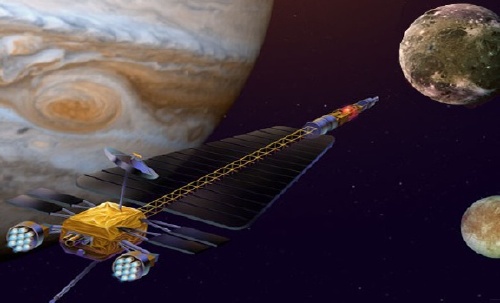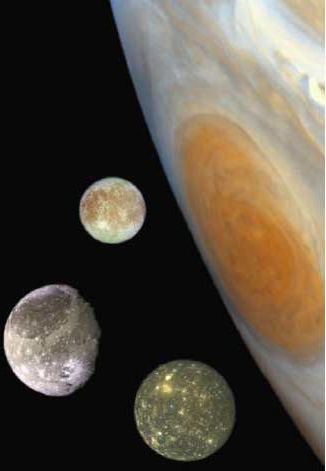 |
|||||
|---|---|---|---|---|---|
| EXPLORING THE JUPITER SYSTEM | |||||
| Jupiter | Moons | Oceans | Volcanos | Rings | Radio |
| JIMO | Galileo | Cassini | Pioneer | Voyager | Resources |

The Jupiter Icy Moons Orbiter
NASA cancelled the Jupiter Icy Moons Orbiter (JIMO) – an ambitious proposal to fly a spacecraft out to Jupiter, orbit three of its planet-sized moons, and study the vast saltwater oceans locked under their icy surfaces.
NASA artist's vision of the moons
Ganymede Europa Callisto near Jupiter
The moons to be orbited by JIMO would have been Europa, Callisto and Ganymede.
JIMO was to be a large-scale spacecraft carrying yet-to-be-developed technology and driven by electric propulsion powered by a nuclear fission reactor. The mission would have been launched sometime around 2015.
JIMO then would have visit Callisto first, then Ganymede, and then Europa.
What might have been: subsurface oceans?
NASA's interplanetary probe Galileo spotted evidence that the large icy moons have three ingredients essential for life – water, energy and necessary chemicals.
For instance, cracks, spots and pits on Europa's surface seem to be signs of an ocean of melted water under the moon's icy shell. Galileo data suggested the melted water had been in contact with the surface in geologically recent times and may remain relatively close to the surface.
Galileo worked around Jupiter from 1995-2003. MORE ABOUT GALILEO
The Galileo evidence for subsurface oceans has been ranked among the major scientific discoveries of the Space Age. JIMO would orbit each of the moons for extensive further investigation of their makeup, their history and their potential for sustaining life.
Why JIMO? The Jupiter Icy Moons Orbiter mission has two objectives:
- To further human exploration by investigating the composition, history and potential for life on the prominent icy moons of Jupiter – Callisto, Ganymede, and Europa. Back in 2002, the U.S. National Research Council ranked the orbiting of Europa by an American probe as a top priority for a "flagship" Solar System mission. Adding Callisto and Ganymede would allow comparisons for understanding how those distant moons evolved.
- To develop a nuclear reactor that can be processed safely and operated reliably in deep space for long-duration deep space exploration. The amount of power available from a nuclear reactor would be hundreds of times greater than other systems used on past interplanetary spacecraft. That would permit the use of more capable instruments and faster data transmission.
Importance of water. If liquid water were to exist on the three icy moons, it would be reasonable to speculate on the existence of life there.
Calisto
Ganymede
EuropaClick image to learn more about the moon
Could it have formed near undersea volcanic vents? After all, life here on Earth has been discovered at great ocean depths, beyond the penetration of sunlight, thriving near undersea volcanic vents on chemical nutrients upwelling from the interior of our planet.
On Earth, upwelling is the process in which nutrient-laden waters from the ocean depths rise toward the surface.
The Electric Ion Propulsion System
What could power JIMO to Jupiter? Its designers plan to use the electric drive system known as ion propulsion.
That kind of drive previously was used successfully by NASA's Deep Space 1 mission, which demonstrated it for interplanetary travel.
Deep Space 1 was launched in 1998. It flew by Asteroid 9969 Braille in1999 and then by Comet Borrelly in 2001. MORE ABOUT DEEP SPACE 1
The difference is Deep Space 1 drew electricity for its thrusters from solar panels. JIMO would draw its electricity from a nuclear fission reactor.
Reaching farther. JIMO would be a much more heavily instrumented craft than Deep Space 1 and would travel much farther from the Sun.
In fact, JIMO will increase dramatically NASA¹s capability for space exploration by developing the use of electric propulsion powered by a nuclear fission reactor.
That technology will make it possible to consider such a large-scale mission as orbiting the moons of Jupiter one after the other. It also will open all of the vast unexplored regions of the outer Solar System for exploration.
Heat from JIMO's nuclear fission reactor would be converted to electricity, giving the probe more than 100 times as much power as a non-fission system of comparable weight.
Project Prometheus. NASA¹s Project Prometheus will develop technology and conduct advanced studies in the areas of radioisotope power system and nuclear power and propulsion for the peaceful exploration of the Solar System.
Organized within the NASA Office of Space Science, Project Prometheus has the goal of developing America's first reactor power for a spacecraft and demonstrating that it can be operated safely and reliably on long duration missions in deep space.
The proposed Jupiter Icy Moons Orbiter would be the first space science mission to incorporate the new capability. MORE ABOUT PROJECT PROMETHEUS
The Science Package
What will the robot scout JIMO be looking for? What are the science goals of the project?What instruments will it carry? NASA will choose JIMO's science equipment once the project receives final approval. The space agency will ask scientists around the world to propose instruments to be carried aboard the Jupiter Icy Moons Orbiter.
- The potential for sustaining life on the moons:
- determining whether the moons actually have subsurface oceans.
- mapping where organic compounds and other chemicals of biological interest might lie on the surface.
- measuring the thicknesses of ice layers to find potential future landing sites.
- The origin and evolution of the moons:
- determining the moons' interior structures, surface features and surface compositions to interpret their evolutionary histories.
- knowing how geology, geochemistry and geophysics work on the moons will help us understand the origin and evolution of Earth.
- The way the moons are weathered by material hitting their surfaces and the radiation environments around the moons:
- the moons orbit within the powerful magnetic environment that surrounds the planet Jupiter.
- they are effected by the natural radiation, charged particles and dust within that environment.
- understanding the radiation and magnetic environment will hep us understand whether or not life arose on those distant moons.
The expanded scientific capacities should allow mapping the surfaces of Callisto, Ganymede and Europa with sufficient detail to see features as smaller than a house.
- JIMO surely will carry a radar for mapping the thickness of surface ice and a laser for mapping surface elevations.
- Undoubtedly, it will have a camera, an infrared imager, a magnetometer, and instruments to study charged particles, atoms and dust that the spacecraft encounters near each moon.
- The generous electrical power supplied by the nuclear system will be able to run instruments with higher power than those flown on other spacecraft and it will boost the data-transmission rate back to Earth.
Special attention will be paid to identifying potential future landing sites.
The Flight Plan
After development and ground-testing of the rocket and spacecraft, a heavy lift expendable launch vehicle would lift the spacecraft into high Earth orbit sometime between 2012 and 2015.
JIMO then would separate from the rocket and the ion-propulsion thrusters would spiral the spacecraft away from Earth on its long run to Jupiter.
Years later, after entering orbit around Jupiter, JIMO would fly into individual orbits around Callisto, then Ganymede, and finally Europa.
Even considering the advanced radiation-resistant electronics that will be built into JIMO, the intensity of the radiation belts at Europa probably would limit how long the spacecraft's instruments would be able to operate in orbit around that moon. Thus, JIMO's work probably would end at Europa.
JIMO management. NASA's Jet Propulsion Laboratory (JPL), a division of the California Institute of Technology in Pasadena, will manage the Jupiter Icy Moons Orbiter project for NASA's Office of Space Science, Washington, D.C.
Collaborators include the U.S. Department of Energy - Idaho (DOE-ID), the Los Alamos National Laboratory (LANL), the Oak Ridge National Laboratory (ORNL), and NASA's Glenn Research Center (GRC), Marshall Space Flight Center (MSFC), and Kennedy Space Center (KSC).
Source: NASA Jet Propulsion Laboratory
The Moons of Jupiter 1. Metis
2. Adrastea
3. Amalthea
4. Thebe
5. Io
6. Europa
7. Ganymede
8. Callisto
9. Themisto
10. Leda
11. Himalia
12. Lysithea
13. Elara
14. S/2000 J11
15. Iocaste
16. Praxidike
17. Harpalyke
18. Ananke
19. Isonoe
20. Erinome
21. Taygete
22. Chaldene
23. Carme
24. Pasiphae
25. S/2002 J1
26. Kalyke
27. Magaclite
28. Sinope
29. Callirrhoe
30. Euporie
31. Kale
32. Orthosie
33. Thyone
34. Euanthe
35. Hermippe
36. Pasithee
37. Eurydome
38. Aitne
39. Sponde
40. Autonoe
41. S/2003 J1
42. S/2003 J2
43. S/2003 J3
44. S/2003 J4
45. S/2003 J5
46. S/2003 J6
47. S/2003 J7
48. S/2003 J8
49. S/2003 J9
50. S/2003 J10
51. S/2003 J11
52. S/2003 J12
53. S/2003 J13
54. S/2003 J14
55. S/2003 J15
56. S/2003 J16
57. S/2003 J17
58. S/2003 J18
59. S/2003 J19
60. S/2003 J20
61. S/2003 J21
62. S/2003 J22
Learn more about Jupiter and its moons and rings:
Solar System Search STO STO cover Questions Feedback Suggestions © 2008 Space Today Online



